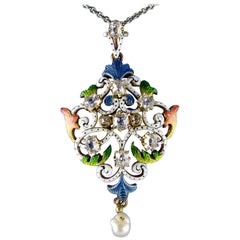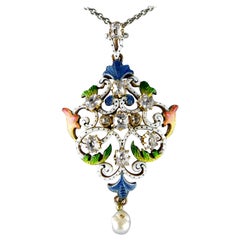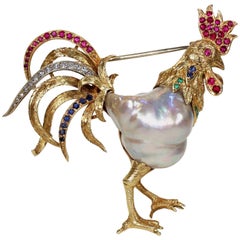Bird On A Pearl Tiffany
Antique Early 1900s British Art Nouveau Pendant Necklaces
Diamond, White Diamond, Pearl, Natural Pearl, 18k Gold
Antique Early 1900s British Art Nouveau Pendant Necklaces
Diamond, White Diamond, Pearl, Natural Pearl, 18k Gold, Enamel
Recent Sales
Vintage 1940s French Retro Brooches
Diamond, Emerald, Natural Pearl, Ruby, Blue Sapphire, 18k Gold, Platinum
People Also Browsed
Antique Mid-19th Century Pendant Necklaces
Blue Sapphire, Sapphire, Pearl, Diamond, Gold, Yellow Gold, White Gold, ...
Vintage 1920s Spanish Art Nouveau Brooches
Diamond, Ruby, 18k Gold, Yellow Gold
Antique 1890s Art Nouveau Pendant Necklaces
Antique 1890s French Art Nouveau Brooches
Diamond, White Diamond, Ruby, Gold, 18k Gold, Yellow Gold
Early 20th Century Russian Russian Empire Pendant Necklaces
Chrysophrase, Gold Plate, Silver, Gilt Metal
Antique Mid-19th Century French Victorian Drop Necklaces
Diamond, Pearl, Ruby, Gold
Antique Early 1900s American Art Nouveau Brooches
Gold, 14k Gold, 18k Gold, Yellow Gold, Enamel
Antique Early 1900s American Edwardian Brooches
Diamond, White Diamond, Gold, 14k Gold, Yellow Gold, Enamel
Antique 19th Century Unknown Art Nouveau Pendant Necklaces
Diamond, Gold, 14k Gold, Yellow Gold, Enamel
Antique 19th Century Unknown Art Nouveau Pendant Necklaces
Pearl, Gold, 14k Gold, Yellow Gold, Enamel
Antique Early 1900s North American Art Nouveau Brooches
Peridot, Natural Pearl, Pearl, Enamel, Yellow Gold, 14k Gold, Gold
Antique Early 1900s American Art Nouveau Pendant Necklaces
Gold, 14k Gold, Yellow Gold, Enamel
Antique 19th Century French Art Nouveau Pocket Watches
Diamond, 18k Gold, Enamel
Vintage 1910s French Art Deco Pendant Necklaces
Turquoise, Lapis Lazuli, White Diamond, Diamond, Carnelian, Yellow Gold,...
Vintage 1910s Art Nouveau Fashion Rings
Blue Sapphire, White Diamond, Enamel, Yellow Gold, 18k Gold, Gold
Antique Early 1900s Unknown Georgian More Necklaces
Silver
The Legacy of Diamond in Jewelry Design
Antique diamond rings, diamond tiaras and dazzling vintage diamond earrings are on the wish lists of every lover of fine jewelry. And diamonds and diamond jewelry are primarily associated with storybook engagements and red-carpet grand entrances — indeed, this ultra-cherished gemstone has a dramatic history on its hands.
From “A Diamond Is Forever” to “Diamonds Are a Girl’s Best Friend,” pop culture has ingrained in our minds that diamonds are the most desired, the most lasting and the most valuable gemstone. But what makes the diamond so special? Each stone — whether it’s rubies, sapphires or another stone — is unique and important in its own right. April babies might claim diamonds for themselves, but just about everyone wants this kind of sparkle in their lives!
There are several factors that set diamonds apart from other stones, and these points are important to our gem education.
Diamonds are minerals. They are made up of almost entirely of carbon (carbon comprises 99.95 percent; the remainder consists of various trace elements). Diamonds are the hardest gemstones, ranking number 10 on the Mohs Hardness Scale. Even its name, diamond, is rooted in the Greek adamas, or unconquerable. The only object that can scratch a diamond is another diamond. Diamonds are formed deep within the earth at very high temperatures (1,652–2,372 degrees Fahrenheit at depths between 90 and 120 miles beneath the earth’s surface) and are carried up by volcanic activity. Diamonds are quite rare, according to the Gemological Institute of America, and only 30 percent of all the diamonds mined in the world are gem quality.
In the 1950s, the Gemological Institute of America developed the 4Cs grading system to classify diamonds: clarity, color, cut and carat weight. Not all diamonds are created equal (there are diamonds, and then there are diamonds). The value of the diamond depends on the clarity (flawless diamonds are very rare but a diamond's value decreases if there are many blemishes or inclusions), color (the less color the higher the grade), cut (how the diamond’s facets catch the light, certain cuts of diamonds show off the stone better than others) and carat weight (the bigger, the better).
When you start shopping for a diamond engagement ring, always prioritize the cut, which plays the largest role in the diamond's beauty (taking the time to clean your diamond ring at least every six months or so plays a role in maintaining said beauty). And on 1stDibs, a range of buying guides can be found for those in the market for antique engagement rings, vintage engagement rings or Art Deco engagement rings.
Shop antique and vintage diamond rings, diamond necklaces and other extraordinary diamond jewelry on 1stDibs.
- Are Tiffany pearls real?1 Answer1stDibs ExpertApril 5, 2022Yes, Tiffany pearls are usually real pearls. Tiffany & Co. uses white Japanese akoya pearls in most of their fine jewelry. A few pieces combine the pearls with diamonds and other gemstones. On 1stDibs, find a selection of Tiffany pearl jewelry.
- 1stDibs ExpertDecember 12, 2023Where Tiffany gets its pearls varies. The luxury jewelry maker's Akoya pearls are from Japan. Other pearls featured on Tiffany & Co. earrings, necklaces, bracelets, brooches and other pieces are sourced from Australia, Tahiti and the Philippines. On 1stDibs, find a selection of Tiffany & Co. pearl jewelry from some of the world's top dealers.
- What grade are Tiffany pearls?1 Answer1stDibs ExpertNovember 6, 2023The grade of Tiffany pearls varies from piece to piece. Generally, the celebrated fine jewelry house uses high-quality pearls with an AAA rating or better. You can find bracelets, necklaces, earrings, rings and brooches featuring Akoya, freshwater and Tahitian pearls in the brand's collection. On 1stDibs, shop a wide range of Tiffany & Co. pearl jewelry.
- 1stDibs ExpertApril 5, 2022Yes, Tiffany & Co. uses real pearls in their jewelry. Tiffany & Co. uses a variety of authentic pearl types, including Japanese Akoya, Tahitian, Chinese Freshwater and South Sea pearls. Shop a wide range of pearl jewelry from Tiffany & Co. on 1stDibs.


